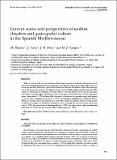Por favor, use este identificador para citar o enlazar a este item:
http://hdl.handle.net/10261/313358COMPARTIR / EXPORTAR:
 SHARE
BASE SHARE
BASE
|
|
| Visualizar otros formatos: MARC | Dublin Core | RDF | ORE | MODS | METS | DIDL | DATACITE | |

| Título: | Situación actual y perspectivas de los cultivos de moluscos (bivalvos y gasterópodos) en el Mediterráneo español |
Otros títulos: | Current status and perspectives of mollusc (bivalves and gastropods) culture in the Spanish Mediterranean | Autor: | Ramón-Herrero, Montserrat; Canoura, Jesús; Peña, J.B.; Campos-Loriz, María Jesús | Palabras clave: | Centro Oceanográfico de Málaga Acuicultura Acuicultura mejillón ostrón ostra plana almeja vieira |
Fecha de publicación: | 1-dic-2005 | Citación: | Boletín. Instituto Español de Oceanografía. 2005. 21 (1-4) | Resumen: | This is a review of the current status, problems and perspectives of bivalve and gastropod culture in the Spanish Mediterranean. Along this coast, bivalve culture has traditionally been located in the two Ebro Delta bays, and in the harbours of Valencia and Mahón, where the main species is the mussel. At present, the Mediterranean mussel Mytilus galloprovincialis Lamarck, 1819 culture is developing in Andalusia. Ostreid culture is currently limited to two species, the Japanese oyster Crassostrea gigas (Thunberg, 1793) in the bays of the Ebro Delta, and the European oyster Ostrea edulis L., 1758 in Santa Pola (Alicante). Cultures of the grooved carpet and Japanese carpet clams, Ruditapes decussatus (L., 1758) and Ruditapes philippinarum (Adamsampersand Reeve, 1850), are located only in the shallow areas of the Ebro Delta. In addition, beds of several species of clams and scallops are distributed along this coast, including the truncate donax Donax trunculus L., 1758, the striped venus Chamelea gallina (L., 1758), the tuberculate cockle Acanthocardia tuberculata (L., 1758) and the smooth callista Callista chione (L., 1758). En este trabajo se revisa la situación actual del cultivo de moluscos bivalvos y gasterópodos en el Mediterráneo español, analizando su problemática y sus perspectivas de futuro. De todo el litoral, el cultivo de moluscos se ha concentrado tradicionalmente en las dos bahías del delta del Ebro y en los puertos de Valencia y Mahón, con el mejillón Mytilus galloprovincialis Lamarck, 1819 como la especie de mayor producción, cuyo cultivo, recientemente, se está desarrollando con éxito en Andalucía. El cultivo de ostreidos se limita en la actualidad a dos especies: el ostrón Crassostrea gigas (Thunberg, 1793) en las bahías del delta del Ebro y la ostra plana Ostrea edulis L., 1758 en Santa Pola (Alicante). El cultivo de almejas Ruditapes decussatus (L., 1758) y R. philippinarum (Adamsampersand Reeve, 1850) se realiza en el delta del Ebro. Además, a lo largo del litoral mediterráneo español existen numerosos bancos naturales de coquina Donax trunculus L., 1758, chirla Chamelea gallina (L., 1758), corruco Acanthocardia tuberculata (L., 1758), almejón Callista chione (L., 1758) y varias especies de almejas y vieiras. |
URI: | http://hdl.handle.net/10261/313358 | ISSN: | 0074-0195 |
| Aparece en las colecciones: | (IEO) Artículos |
Ficheros en este ítem:
| Fichero | Descripción | Tamaño | Formato | |
|---|---|---|---|---|
| 102-100-1-PB.pdf | 1,18 MB | Adobe PDF |  Visualizar/Abrir |
CORE Recommender
Este item está licenciado bajo una Licencia Creative Commons

